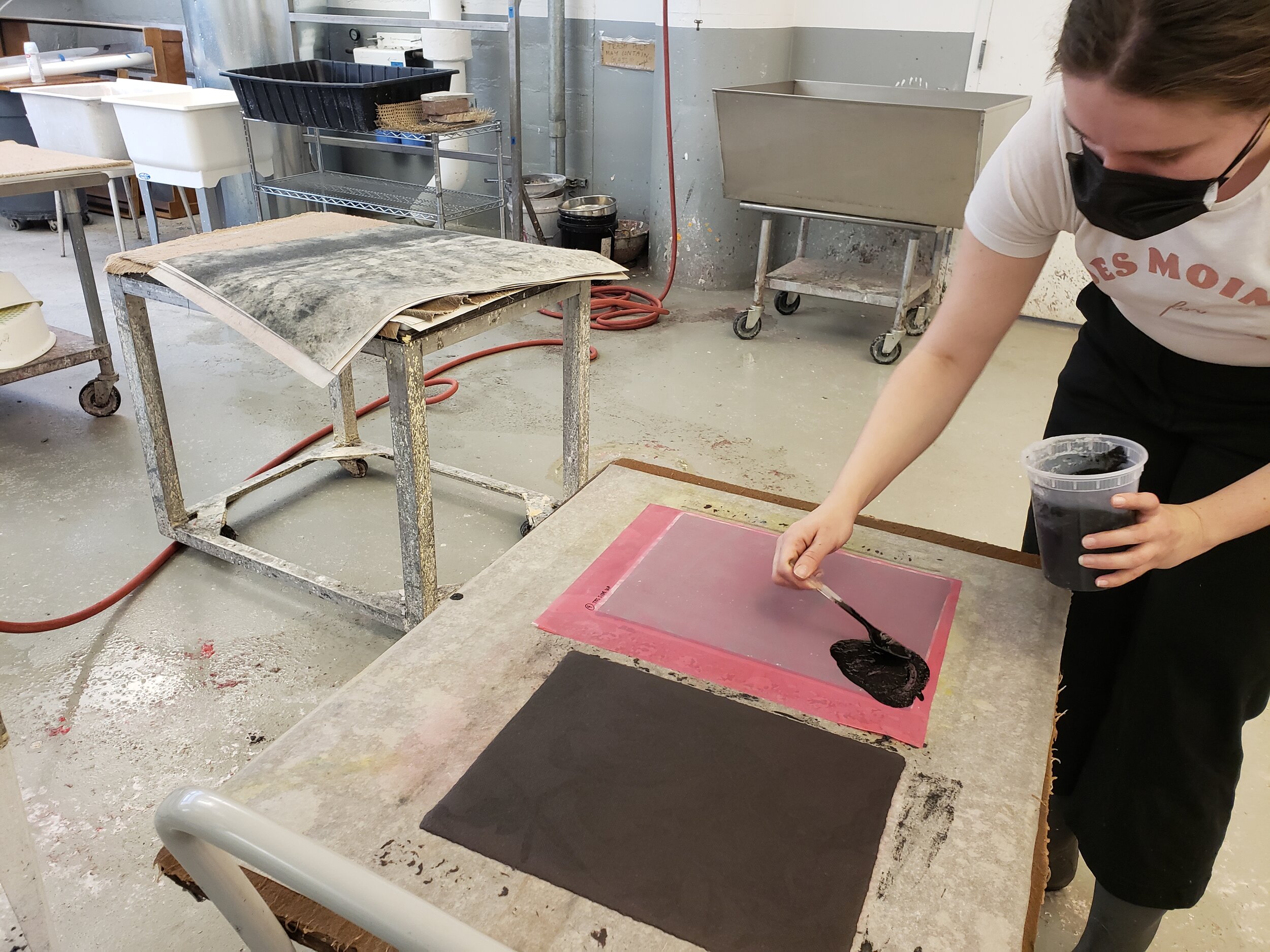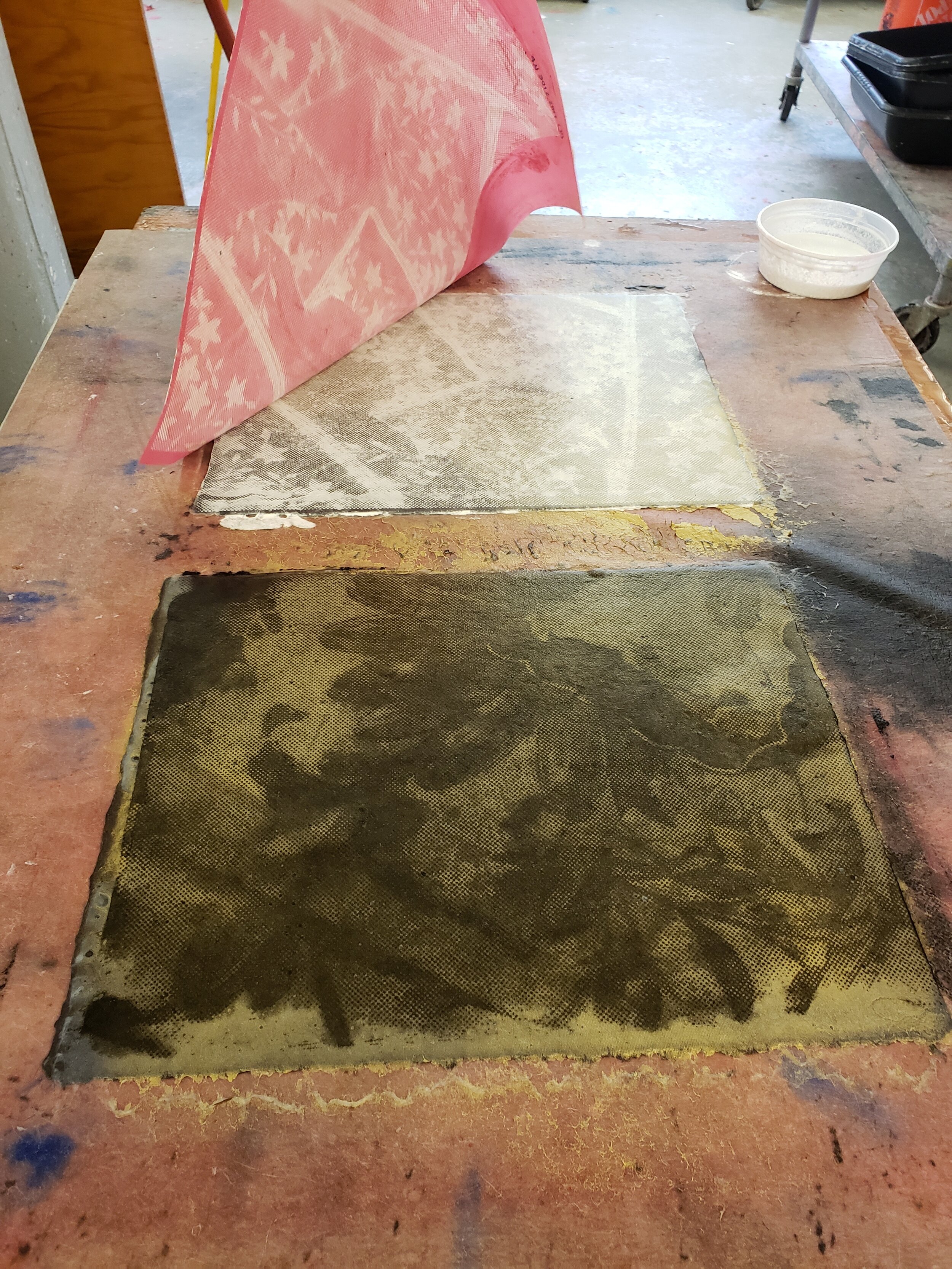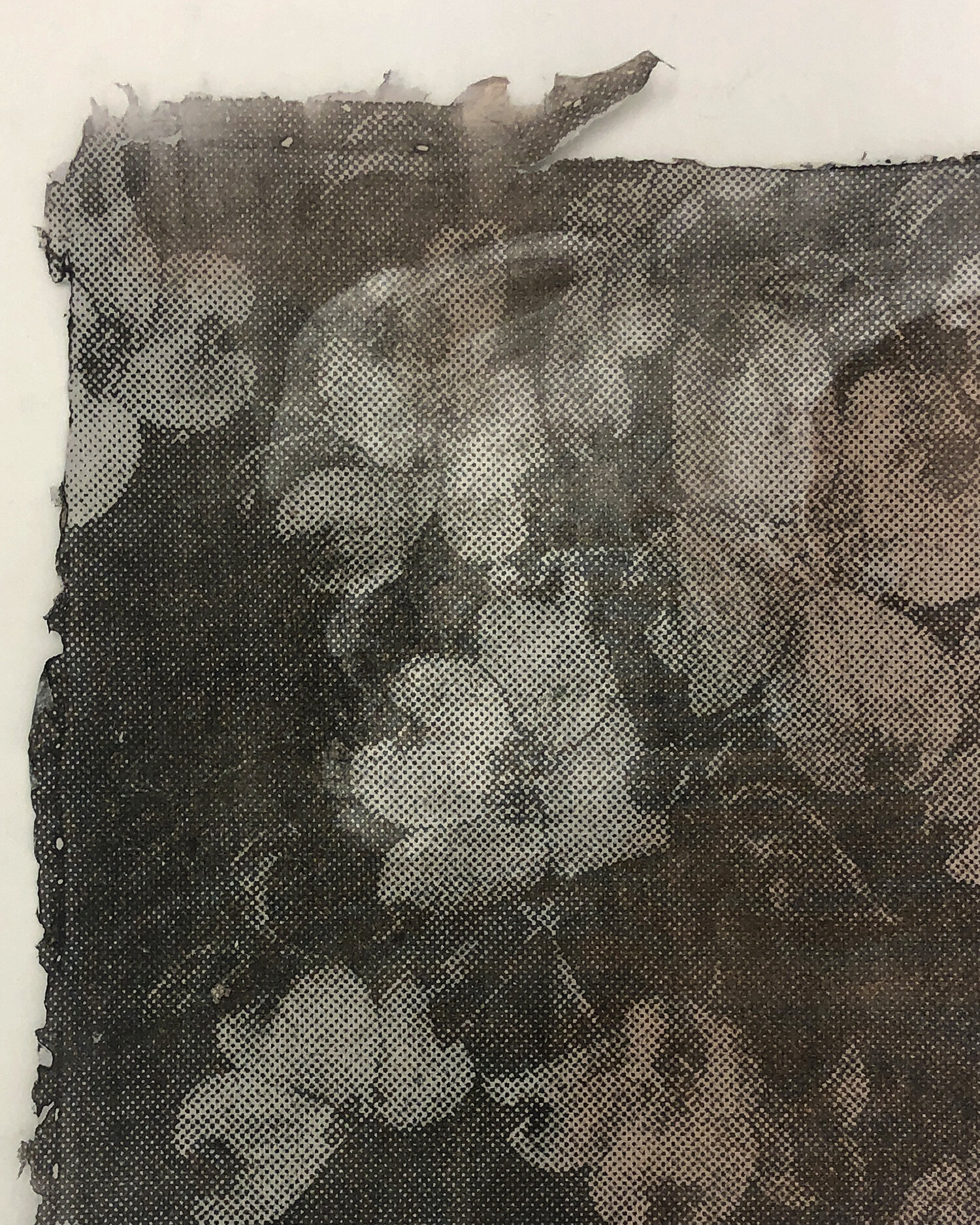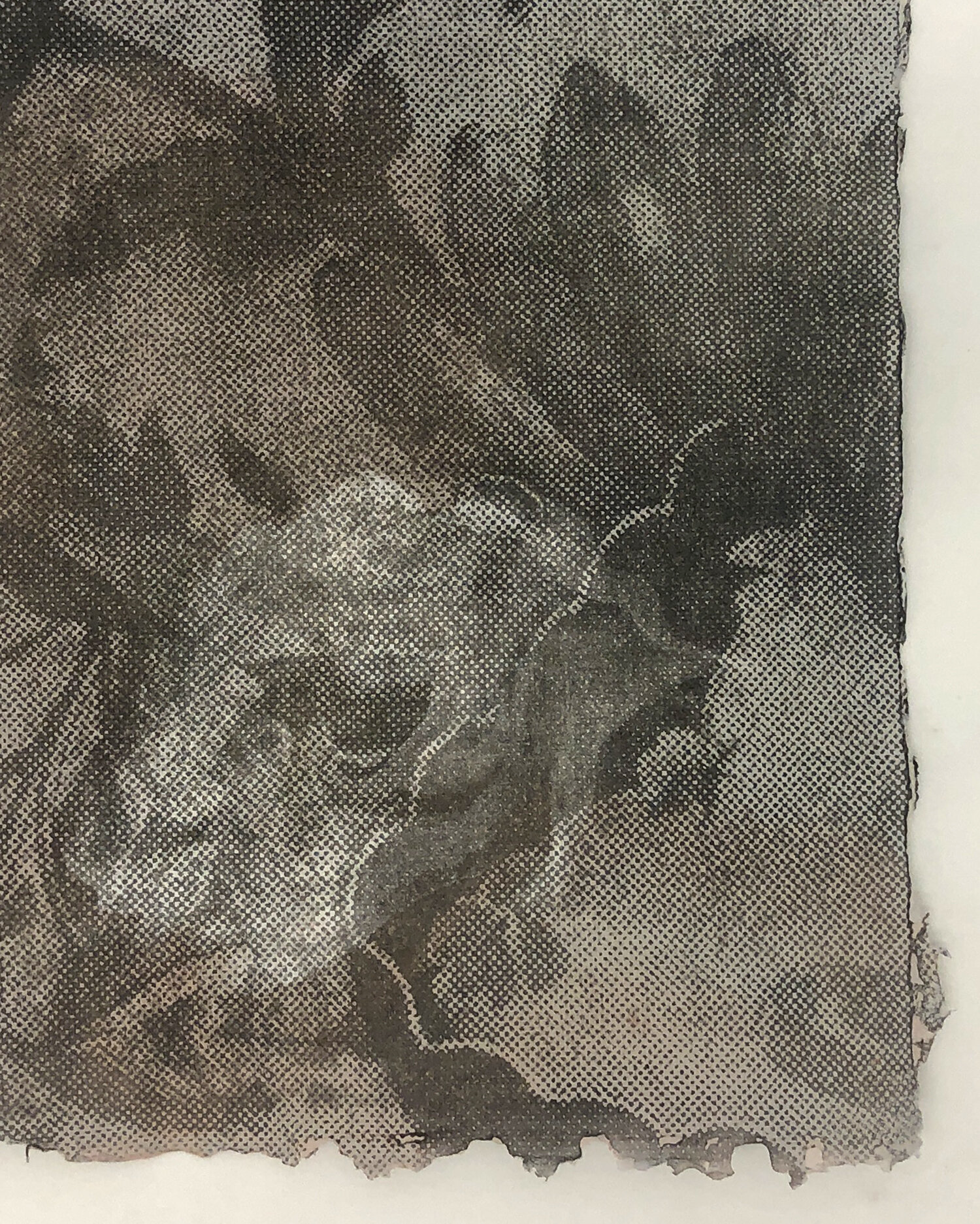Katharine L. DeLamater
Katharine L. DeLamater
2020 West Bay View Foundation Fellow
As a West Bay View Fellowship recipient, Katharine L. DeLamater joined us at Dieu Donné in late August 2020. Joining us admist a pandemic, Katharine’s fellowship provided her access to our studios, a stipend, and close guidance from our artistic directors to push her understanding of collaboration and her own artistic practice. The artist shares their fellowship experience through a short Q & A and previously recorded Webinar below.
What were you doing before your fellowship?
I earned my MFA from the University of Iowa Center for the Book in May 2020. While in Iowa I worked as Tim Barrett's research assistant at the Oakdale Papermaking Research Facility for two years and on archive projects with the Digital Publishing Studio at the University of Iowa Libraries. For my thesis work, I created two editioned artists books that were exhibited alongside unique handmade paper paintings. In addition to this visual artwork, I also wrote an essay that analyzed the history of collaboration in papermaking and its influence on contemporary fine arts publishing studios.
What did this fellowship offer?
The WBV Fellowship gave me an opportunity to continue to explore my creative inclinations after graduate school. After working primarily with editioned works during my MFA, I was eager to return to the possibilities and instant gratification offered by the hand papermaking process. I also had the opportunity to work independently on a collaboration with artist LaKela Brown, which helped me build confidence in my skills as a collaborator and put my research into practice.
Artist LaKela Brown and fellow Katharine DeLamater working in the professional studios at Dieu Donné, February 2021.
What artists did you work with during your fellowship? Please speak briefly about your experiences.
I had limited interactions with artists during my fellowship due to COVID-19. I did however get to work on tests/research projects for Chris Bogia, Damien Davis, Terry Winters, Do-Ho Suh, and Lauren Luloff. The main focus was my work with LaKela Brown, for which I did several weeks of testing in addition to our time together in the studio.
What papermaking techniques were most exciting to you, either in your own work, or used at DD during your fellowship?
As it happens every time I am at Dieu Donne, I tend to incorporate techniques I see others using around the studio into my own work. During my fellowship I continued to experiment with stencils since we were using stencil matrices as a way to work remotely with artists. Sarika and I worked together using DD's new vinyl cutter to cut perpendicular matrices varying in size from 11 x 14 to 22 x 30 inches for blow-outs and pulp painting. It was helpful and a new experience to have the technology on-site to be able to create several matrices in the course of an afternoon.
What were your favorite fibers, pigments, etc?
I had never used luster / metallic pigments before this fellowship. I started to pigment using Aarvark Colors luminous silver and antique gold as a way to bring the feeling of drawing media (e.g. graphite) into the wet stage of the papermaking process and to continue to experiment with the subtleties of light reflection of the dried artwork.
Tatiana Ginsberg (Co-Director of Artistic Projects and Master Collaborator), and Katharine DeLamater in the professional studio, March 2021.
What else did you work on during your fellowship?
I worked with the historical archive of Dieu Donne stock papers that were created primarily between 1977 and 2003 to document how papers were being made at that time (lots of cotton rag). This dovetailed with my general interest in archives work and my personal mission to chronicle as much information as possible before it is lost to history.
Who was your collaborator (thus far) and what did you learn from them or the experience?
I've worked with Tatiana thus far for my studio days (I have two remaining). Tatiana and I met when I was a sophomore at Mount Holyoke College and enrolled in her printmaking class. Much of my career as an artist has been impacted by the formative projects I did in Tatiana's classes, so it was a privilege to come together eight years later to work together as peers. It's a rare and special opportunity to be able to work with someone who witnessed the germination of your studio practice overtime, and that informed our time working together. For example, she knows that I like to work on several projects at once (both in the studio and in my life). We came up with a plan that allowed me to try out several ideas at once while moving towards the ever-elusive "completed" project.
How did you benefit from access to the studios?
Since I was unable to travel to see my family, alone for the holidays in a new city, the studio staff encouraged me to create a "residency" for myself the week-long break at the end of December. During this week, I experimented with a lot of newly formed ideas around techniques I wanted to try so that I could bring samples to Amy and Tatiana to discuss plans for my professional studio days.
I lost studio access in Iowa the day after my thesis exhibition reception due to the pandemic which meant I moved to New York with an artists' book project that was never fully realized. So much has shifted for me professionally and personally since I wrote the text for the book in 2019 and this project has naturally also evolved. I'd made some of the paper for the project in Iowa (a dreamy batch of overbeaten raw flax) and I made two more batches of paper at Dieu Donne that I think will also make an appearance in this project (inky black and blue abaca sheets with metallic washes).
How has the fellowship given you other opportunities?
Early on in my fellowship, Tatiana put me in touch with Donna Koretsky, co-founder of Carriage House Paper, to work on an essay about the history of Carriage House Paper and its impact on the field of hand papermaking over the past forty-plus years. As my fellowship came to an end, an opportunity to join Carriage House as Studio Manager and Art Director presented itself. I've now happily settled into my role at Carriage House on Kent Avenue in Williamsburg and I'm very pleased that Dieu Donne is only just a couple of miles away. My essay on Carriage House will be published in the forthcoming second volume of Papermaker's Tears (The Legacy Press).
Once Dieu Donne can safely resume in-person educational outreach, I will be joining the crew of rotating instructors for studio classes. I also look forward to collaborating with Dieu Donne and maintaining the friendships I've made there throughout the years.
Katharine L. DeLamater (Dieu Donné 2020-2021 West Bay View Fellow) and Tatiana Ginsberg (Director of Artistic Projects) discuss DeLamater’s fellowship and the body of work she created in the Dieu Donné studios from 2020-2021. This Webinar was recorded live on March 25th, 2021.
About the Artist
Katharine L. DeLamater is a Studio Collaborator at Dieu Donné. She studied art and philosophy at Mount Holyoke College and received her MFA from the University of Iowa Center for the Book. She is the recipient of an Iowa Arts fellowship and a West Bay View Foundation Fellowship which supported her development as a hand papermaker, artist, and educator. Her writing on authorship and collaboration was first published by Hand Papermaking Magazine. Alongside teaching and artist collaborations, Katharine maintains her own artistic practice which includes papermaking, letterpress printing, and experimental bookbinding.
For more information, please visit: https://www.katharinelarkdelamater.com or follow her on Instagram @katharinelark



















